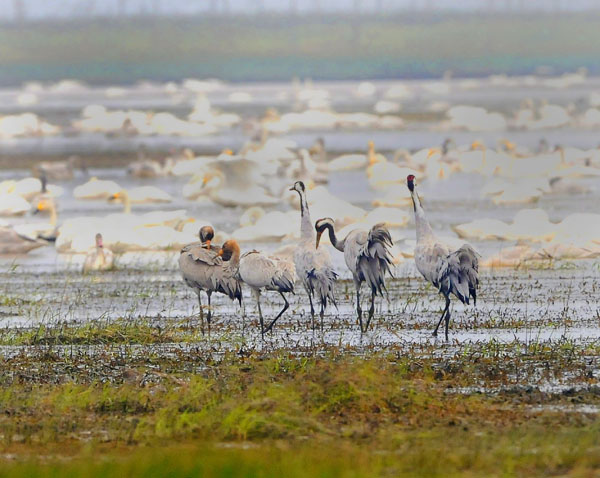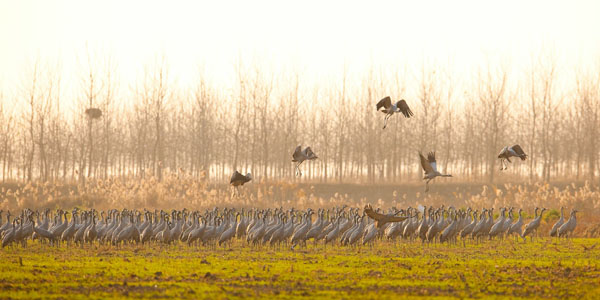Grus grus
IUCN
LCBasic Information
Scientific classification
- name:Grus grus
- Scientific Name:Grus grus,Common Crane,Thousand-year-old crane, black crane, sweet potato crane
- Outline:Wading birds
- Family:Gruiformes Gruiformes Grus
Vital signs
- length:95-125cm
- Weight:3-5.5kg
- lifetime:50years
Feature
The grey crane is the most numerous and widely distributed species of crane in the world, with an existing population of over 700,000.
Distribution and Habitat
In China, they breed in the northeast and northwest regions, and migrate south to North China, Central China, and Southwest China in winter. Abroad, they are distributed in the Palearctic, and a small number appear in northern Southeast Asia.
They move in pairs or small groups in their breeding grounds. During migration and wintering, they can gather in large groups of up to hundreds, resting and feeding in farmland or near-water wetlands.
Appearance
It is of medium size, with black front and back of the head and red center, blue-gray or black head and neck, a wide white stripe from behind the eye to the nape of the neck, the rest of the body feathers are gray, the back, coverts and tertiary flight feathers are slightly brown, and the primary and secondary flight feathers are dark gray. The head and front of the neck of the young bird are light brown-yellow. The iris is brown, the beak is dirty green, the tip of the beak is yellowish, and the feet are black.
Details
Grey cranes are large wading birds with obvious identification characteristics in the wild. They have very long necks and legs, and their feathers are mostly gray. The bare skin on the top of the head is bright red, and there are sparse black hair-like short feathers. There is a gray-white vertical band from the back of the eye to the side of the neck, and the feet are black.

They move in pairs or small family groups of 5 to 10 during the breeding season. During the migration period, they can gather in groups of up to 40 to 50. In the wintering grounds, they can gather in large groups of up to hundreds of people, and fly in a "V" formation. They are alert and timid. When the cranes are active and foraging, there is often a crane responsible for vigilance. It can find food on land and in water. Call: A high-pitched, persistent and penetrating trumpet sound, and a deep and loud "karr" sound when flying.
Omnivorous, but mainly plants, including roots, stems, leaves, fruits and seeds. It likes to eat the roots and leaves of reeds. In summer, it also eats insects, earthworms, frogs, snakes, mice, etc. It can use new habitats and adapt to different foods in different habitats, from aquatic plants, grains and seeds to small invertebrates.
Cranes are common migratory birds in my country. They breed in Northeast and Northwest my country, winter in most areas of North China, Central China and Southwest China, and occasionally go to East China and South China and Taiwan. Every spring and autumn migration, the gray crane passes through Heilongjiang, Jilin, Liaoning, Hebei, Shandong, Henan, Shaanxi, Shanxi, Inner Mongolia, Anhui, Tianjin, Sichuan and other places in my country. Some areas are both wintering grounds and stopovers during migration, such as Liaoning, Hebei, Tianjin, Henan, Shaanxi, Shanxi, etc., where the number of cranes is often large during the migration season, and only a small number or part of them stay for the winter.

Grey cranes are the crane species with the widest distribution range and the largest number of wintering populations in my country. The 2021 China Crane Wintering Synchronous Survey showed that grey cranes are distributed in 20 provinces (autonomous regions, municipalities directly under the central government). Among them, a new grey crane wintering ground was discovered in Chifeng City, Inner Mongolia, which is the northernmost boundary of the grey crane wintering distribution area in my country. Jiangxi, Xinjiang, Hebei, Liaoning, Shandong and other five provinces are the main wintering distribution areas of grey cranes in my country, followed by Ningxia, Henan, Tianjin, Jiangsu, Shanxi, Shaanxi, Inner Mongolia, Beijing, Hunan and other nine provinces (autonomous regions, municipalities). Poyang Lake in Jiangxi is the largest wintering place for grey cranes in my country, with a population of more than 20,000; followed by Jinzhou, Liaoning, Aksu Prefecture, Xinjiang, Hengshui Lake National Nature Reserve in Hebei, Yellow River Beach in Shandong, and Yuncheng Wetland Nature Reserve in Shanxi, with wintering populations exceeding 3,000. The wintering habitats of grey cranes are mainly farmland (including wheat fields, rice fields, corn fields and other farmland, accounting for 52.80%) and wetlands (including reed swamps, rivers, lakes, etc., accounting for 40.00%).
Listed in the second level of China's "National Key Protected Wildlife List" (February 5, 2021).








